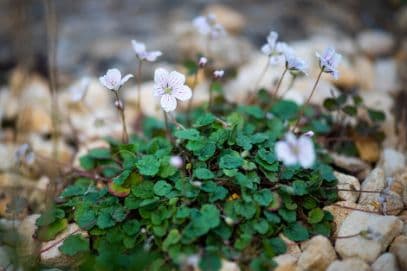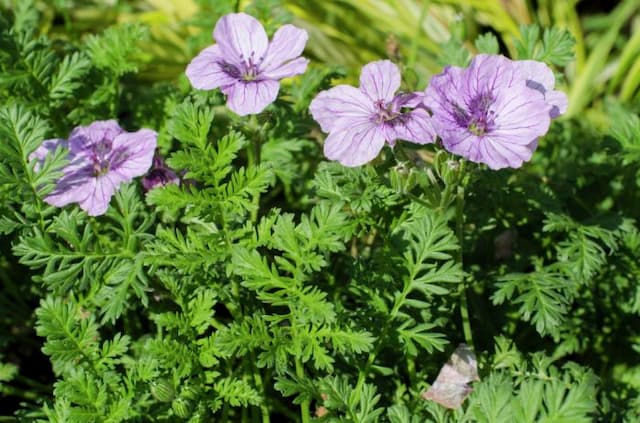Geranium Pelargonium Solidor (I/d)
![pelargonium [Solidor]](/_next/image?url=https%3A%2F%2Fplants-admin.emdemapps.com%2Fimages%2Fplants%2F%2Fimages%2F604b5a7f16a23.png&w=3840&q=75)
ABOUT
The "Pelargonium Solidor" is a vibrant and ornamental plant known for its richly colored flowers and attractive foliage. This particular variety boasts beautiful blooms that come in a range of colors, often displaying multicolored petals which can feature a combination of hues such as pinks, reds, purples, and sometimes with contrasting markings or veins that make each flower stand out. These flowers are typically rounded in shape and grow in clusters, creating a showy display that can catch the eye from a distance. The leaves of the Pelargonium Solidor add to its decorative appeal, with a lush and bushy formation characterized by a medium to dark green color. The foliage may also exhibit a unique zonal pattern, with darker concentric circles that can vary in intensity. This pattern adds depth and texture to the plant's overall appearance. The leaves themselves are usually heart-shaped or rounded, with a soft, velvety feel, and they may sometimes feature serrated or slightly scalloped edges. This plant, popular amongst gardeners and houseplant enthusiasts alike, is appreciated for its easy care requirements as well as its ability to provide a long-lasting splash of color to any setting. Whether grown in pots, containers or garden beds, the striking flowers and attractive foliage of the Pelargonium Solidor make it a delightful addition to both indoor and outdoor spaces. Its aesthetic charm is further enhanced when it's paired with other plants, creating a lush and vibrant garden display.
About this plant
 Names
NamesSynonyms
Scented Geranium, Sweet-Scented Geranium
Common names
Pelargonium Solidor.
 Toxicity
ToxicityTo humans
The Pelargonium Solidor, commonly known as geranium, is generally considered non-toxic to humans. However, ingestion of large quantities of geranium plant parts may cause mild gastrointestinal upset including vomiting and diarrhea.
To pets
Geraniums can be toxic to pets, particularly to cats and dogs. If ingested, they may cause symptoms such as vomiting, anorexia, depression, and dermatitis. In severe cases, ingestion may lead to more serious consequences including renal failure or death, so it is important to keep geraniums out of reach of pets and seek veterinary care if ingestion is suspected.
 Characteristics
CharacteristicsLife cycle
Perennials
Foliage type
Evergreen
Color of leaves
Green
Flower color
Varies
Height
1-2 feet (30-60 cm)
Spread
1-2 feet (30-60 cm)
Plant type
Herb
Hardiness zones
9
Native area
South Africa
Benefits
 General Benefits
General Benefits- Easy to grow - Pelargonium Solidor is known for being a low-maintenance plant that can thrive with basic care.
- Drought tolerant - It has good drought resistance once established, making it suitable for arid climates or water-saving gardens.
- Long blooming season - This plant has a prolonged flowering period, providing color and vibrancy to gardens for an extended time.
- Attracts pollinators - The flowers can attract beneficial insects like bees and butterflies, helping to pollinate other plants in the garden.
- Versatile gardening uses - It can be used in borders, containers, hanging baskets, and as a bedding plant, offering various landscaping options.
- Aesthetic appeal - With its bright, colorful blooms and attractive foliage, it enhances the visual appeal of any garden space.
- Resistant to pests - Pelargonium Solidor is resistant to many common garden pests, reducing the need for chemical treatments.
 Medical Properties
Medical PropertiesThis plant is not used for medical purposes.
 Air-purifying Qualities
Air-purifying QualitiesThis plant is not specifically known for air purifying qualities.
 Other Uses
Other Uses- Decorative cake embellishment - Pelargonium petals can be crystallized or used fresh to adorn and add a subtle flavor to cakes and desserts.
- Insect repellent sachets - Dried scented geranium leaves can be placed in sachets to deter moths and other insects from closets and drawers.
- Natural dye - The vibrant flowers and leaves of the scented geranium can be used to create natural dyes for fabrics or paper crafts.
- Homemade potpourri - The strongly scented leaves can be dried and mixed with other botanicals to create a fragrant potpourri.
- Flavoring for jams and jellies - Scented geranium leaves can impart unique flavors when infused in jams, jellies, and preserves.
- Culinary infusions - Leaves can be infused in sugars or salts to create uniquely flavored condiments.
- Companion planting - Scented geraniums can be grown alongside other plants in the garden to help repel pests with their strong fragrance.
- Floral arrangements - Fresh or dried scented geranium flowers can add beauty and aroma to flower arrangements.
- Scenting candles and soaps - The essential oils of scented geraniums can be used in homemade candles and soaps for their fragrance.
- Relaxing foot bath - Leaves and flowers can be steeped in hot water to create a fragrant and soothing foot bath.
Interesting Facts
 Feng Shui
Feng ShuiThe Geranium is not used in Feng Shui practice.
 Zodiac Sign Compitability
Zodiac Sign CompitabilityThe Geranium is not used in astrology practice.
 Plant Symbolism
Plant Symbolism- Comfort: Pelargoniums, commonly known as geraniums, have a soothing fragrance and are often associated with providing comfort and easing the mind.
- Positive Emotions: Geraniums are often connected with happiness and positive feelings due to their bright, cheerful flowers and pleasant scent.
- Friendship: Giving a geranium as a gift can symbolize a wish for deeper friendship or the enhancement of a current friendship, as the plant is seen as a symbol of companionship.
- Healing: Geraniums are believed to have healing properties, and in the language of flowers, they can represent the healing and regeneration of good health or spirits.
 Water
WaterGeraniums like the Pelargonium Solidor prefer to be watered when the top inch of soil feels dry to the touch. Typically, this means watering thoroughly once every 1 to 2 weeks, allowing water to run through the drainage holes at the bottom of the pot. During the active growing season in spring and summer, provide about 8 to 12 ounces of water per plant, depending on the pot size and environmental conditions. Reduce watering in the fall and winter months to prevent waterlogging, as this can lead to root rot.
 Light
LightGeraniums, such as the Pelargonium Solidor, thrive best in bright, indirect sunlight. They can be placed in an east-or west-facing window where they receive at least 4 to 6 hours of sunlight daily. Direct afternoon sun can be harsh, especially in warmer climates, so a location that receives morning sunlight or filtered afternoon light is ideal for these plants.
 Temperature
TemperatureGeraniums like the Pelargonium Solidor thrive in temperatures ranging from 65°F to 75°F during the day and should not be exposed to temperatures below 50°F, as they are not cold-hardy. They can survive short periods of higher temperatures, but prolonged exposure to temperatures above 85°F may stress the plant. The ideal temperature range for geraniums is close to room temperature, offering some flexibility but prioritizing a warmer and stable environment.
 Pruning
PruningGeraniums, like Pelargonium Solidor, should be pruned to encourage bushy growth and to remove faded or dead flowers and leaves. Pruning is best done in the early spring before the onset of new growth, or throughout the growing season as needed. Older plants can be rejuvenated by cutting back a third of the growth. Deadheading, or the removal of spent blooms, should be done regularly to promote continuous flowering.
 Cleaning
CleaningAs needed
 Soil
SoilGeraniums thrive in well-draining soil with a pH ranging from 6.0 to 7.5. A mix of one part peat moss, one part perlite, and one part compost is ideal for providing the right balance of drainage and moisture retention for Pelargonium Solidor.
 Repotting
RepottingGeraniums should be repotted every one to two years to provide fresh soil and encourage growth. If the plant has outgrown its current pot, repot it in the spring before new growth starts.
 Humidity & Misting
Humidity & MistingGeraniums prefer moderate to low humidity levels. They can tolerate dry air well, so maintaining indoor humidity between 30% to 50% is ideal for Pelargonium Solidor. Avoid excessively high humidity to prevent fungal diseases.
 Suitable locations
Suitable locationsIndoor
Place geranium in bright light, avoiding direct midday sun.
Outdoor
Plant in well-draining soil; ensure full to partial sun.
Hardiness zone
9-12 USDA
 Life cycle
Life cycleGeranium 'Solidor' (Pelargonium × hortorum) begins its life as a seed, with germination occurring under warm conditions after sowing. Upon sprouting, the seedling enters a vegetative stage where it develops a rosette of leaves and establishes a root system. As the plant matures, it enters a rapid growth phase where stems elongate and new leaves form, leading to the development of the distinct Geranium foliage. The next stage is the flowering period, which occurs when the plant has sufficient energy and daylight to produce vibrant red, pink, or white flowers, often in clusters, attracting pollinators. After pollination, if successful, the plant produces seed capsules, completing the reproductive cycle. Finally, as a perennial in warm climates but often treated as an annual in temperate zones, the Geranium 'Solidor' may either die back in cold weather or persist and enter a period of dormancy before resuming growth in the next season.
 Propogation
PropogationPropogation time
Spring-Summer
Pelargonium, commonly known as geranium, is a plant that can be easily propagated by cuttings, a method favored for its simplicity and effectiveness. The best time to propagate geraniums through cuttings is during the late summer to early fall when the plant is actively growing. To propagate by cuttings, a healthy non-flowering shoot should be selected. Cut a 4 to 6 inch (about 10 to 15 centimeters) length, making sure that there are at least three nodes present. The bottom leaves of the cutting are removed, and the cut end is allowed to dry and callous for a couple of hours. Afterward, the cutting is planted in a moist, well-draining soil mix, with about half of the cutting buried, including two nodes. Rooting hormone can be applied to the cut end to encourage root growth, but this is optional. The cutting should then be placed in bright, indirect light and kept at a temperature of around 70°F (approximately 21°C), ensuring the soil stays damp but not waterlogged until roots have established, usually within a few weeks.




![Cranesbill [Blue Sunrise]](/_next/image?url=https%3A%2F%2Fplants-admin.emdemapps.com%2Fimages%2Fplants%2F%2Fimages%2F604b638d45948.png&w=640&q=75)




